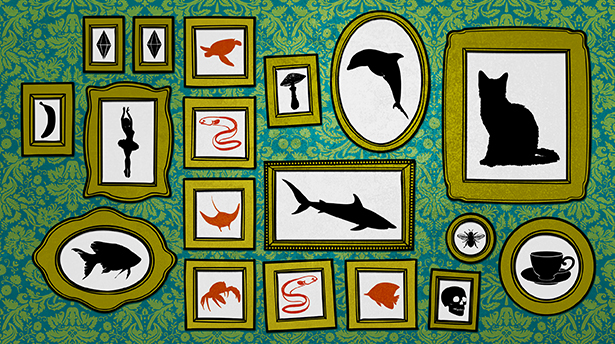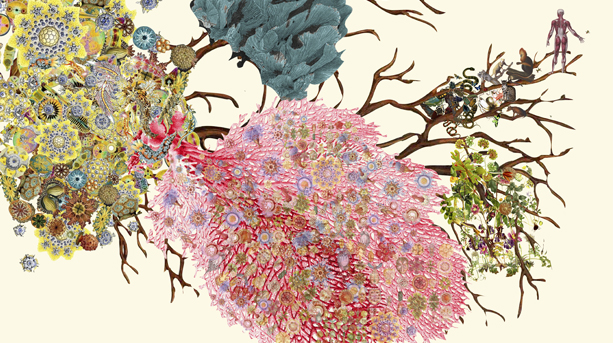The Slippery Eel of Probability
In school, we are trained to think that math problems always have one correct answer. But this is not necessarily true for problems dealing with probability, if the method used to reach the described situation is not fully specified. Surprisingly, the same problem can then have many different answers, all apparently equally valid. Take, for example, our new puzzle:
An art collector who loves pictures of sea creatures, especially eels (there’s no accounting for taste!), commissions an art project. In his living room, he arranges a set of six blank canvases in an L-shaped configuration, with four in a vertical column and three in a horizontal row (the corner canvas is part of both). He hires an artist, with these instructions: “You can paint a single sea creature of your choice on each of these canvases, with one condition. I would like to see a picture of an eel when I move my gaze vertically or horizontally. So there must be at least one eel in the vertical column and at least one in the horizontal row.” The artist does this, following her own preferences when they do not conflict with the instructions.
What is the probability that the corner canvas has a picture of an eel?
To make this concrete, if your friend offered to pay you $2 if the corner canvas did not have a picture of an eel, and you had to pay her just $1 if it did, would you take the bet? Assume that your friend knows exactly what you do about the situation. (Update: The solution is now available here.)
The first possible naïve answer that may come to mind is that the probability is one in four because there are four vertical pictures, or perhaps one in three because there are three horizontal ones. Is either answer correct? Are both?
The last question is not facetious. There is a famous problem in probability known as Bertrand’s paradox whose statement is simple: What is the probability that a random chord of a circle is larger than the side of the equilateral triangle inscribed in the circle? To do this you have to determine the density of such chords by “counting” how many are larger than the side of the triangle and dividing that by the total number of chords. The answer can be ¼, ⅓ or ½, depending on how the chords are counted. All of these answers are correct in different circumstances.
“Wait a minute,” you might say, “that’s because there are an infinite number of chords in a circle, and counting infinities is always problematic. It can’t happen when the numbers are finite.” But it can when, as above, the method of accomplishing a task is not clearly specified to a T (or L!). Probability is a fluid beast, slippery as an eel, one that can appear in many different places at the same time if all the avenues of ambiguity are not completely nailed down.
Why should this be? One reason is that probability is actually a hybrid beast, with two faces that can sometimes be at odds with each other. The first of these two aspects is the objective or constant part — how frequently an event actually occurs over the course of multiple trials (this is known as frequentist probability). The second is the subjective or changeable part: the degree of our knowledge or ignorance about the possibility of something happening (this is known as Bayesian probability).
Another possible reason for multiple answers is that, when conditions in a problem are unspecified or unknown, mathematicians make use of something called the “principle of indifference” or “principle of insufficient reason.” If there are several different, mutually exclusive scenarios that could take place in a situation, mathematicians assign equal probability to each of them, at least as a first guess. In problems that involve picking numbers from known ranges, this amounts to choosing uniform distributions. Sometimes this is just not possible, as we saw in the previous puzzle. And sometimes there are several equally valid ways of applying the principle of indifference that may yield different probabilities.
For today’s puzzle, I want readers to shake off their school-induced “fear of being wrong” and generate as many valid answers as they can. There are many different ways the artist could have completed the task, and each of these may yield a different answer. Furthermore, all you have to do to solve this month’s puzzle is count. It may be hard to believe, but finding probabilities is just glorified counting! Of course, once you make your assumptions, you have to do the counting right. The ambiguity in such problems lies in the problems not being fully specified, not in the laws of probability, which admit only one result when all the conditions are nailed down.
So let’s try to identify all the various places where the slippery eel of probability could turn up. One or two of the answers could be termed “mathematically favored,” but the others are valid too. In fact, in real life, as with the solution to the previous puzzle, the mathematically favored answers may not always be the best ones. With your answer, also specify your assumptions — the personal preferences, if any, that the artist may have brought to her task. As you do this, you may realize that we actually apply probabilities all the time in real life, weighing psychology and context, whether consciously or unconsciously, emotionally or rationally, intuitively or analytically. Bayesian probability is the basis of all our beliefs, and to a large extent our success in life is related to how nimble we are in keeping up with the slippery beast of probability.
More mathematically adventurous readers can try and invent their own clearly stated probability problem that could have several different answers because the principle of indifference can be applied in more than one valid way. Happy puzzling, and may the insight be with you!
Editor’s note: The reader who submits the most interesting, creative or insightful solution (as judged by the columnist) in the comments section will receive a Quanta Magazine T-shirt. And if you’d like to suggest a favorite puzzle for a future Insights column, submit it as a comment below, clearly marked “NEW PUZZLE SUGGESTION” (it will not appear online, so solutions to the puzzle above should be submitted separately).
Update: The solution has been published here.




